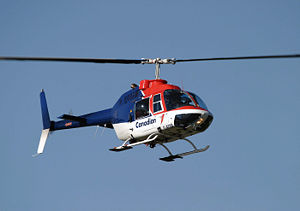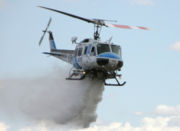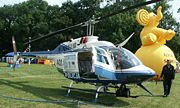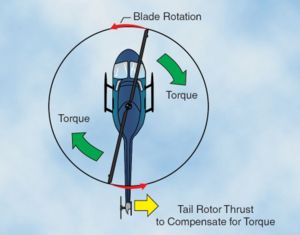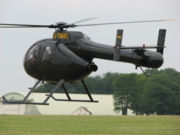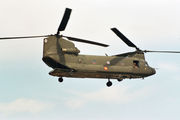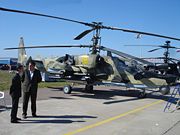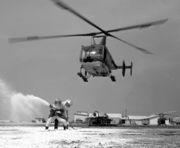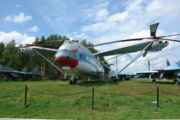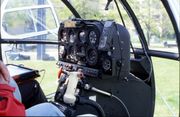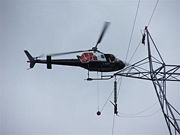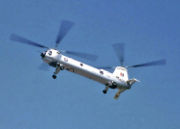Helicopter
2008/9 Schools Wikipedia Selection. Related subjects: Air & Sea transport
| Helicopter | |
|---|---|
| A Canadian Helicopters Bell 206 |
A helicopter is an aircraft which is lifted and propelled by one or more horizontal rotors, each rotor consisting of two or more rotor blades. Helicopters are classified as rotorcraft or rotary-wing aircraft to distinguish them from fixed-wing aircraft because the helicopter derives its source of lift from the rotor blades rotating around a mast. The word 'helicopter' is adapted from the French hélicoptère, coined by Gustave de Ponton d'Amecourt in 1861. It is linked to the Greek words helix/helik- (ἕλικ-) = "spiral" or "turning" and pteron (πτερόν) = "wing".
As an aircraft, the primary advantages of the helicopter are due to the rotor blades that revolve through the air, providing lift without requiring the aircraft to move forward the way an airplane does. This creates the ability for the helicopter to take off and land vertically without the need for runways. For this reason, helicopters are often used to operate in congested or isolated areas where airplanes are generally not able to take off or land. The lift from the rotor also allows the helicopter to hover in one area for extended periods of time, and to do so more efficiently than other forms of vertical take-off and landing ( VTOL) aircraft, allowing it to accomplish tasks that airplanes are unable to perform.
Although helicopters were developed and built during the first half-century of flight, some even reaching limited production, it wasn't until 1942 that a helicopter designed by Igor Sikorsky became the first helicopter to enter full-scale production, with 131 aircraft built. Even though most previous designs utilized more than one main rotor, it was the single main rotor with antitorque tail rotor configuration of this design that would come to be recognized worldwide as the helicopter.
History
Since 400 BC, Chinese children have played with a bamboo flying top. Eventually, this flying top made it to Europe and is depicted in a 1463 European painting. Pao Phu Tau (抱朴子) was a 4th-century book in China reported to describe some of the ideas inherent to rotary wing aircraft:
| “ | Someone asked the master about the principles of mounting to dangerous heights and traveling into the vast inane. The Master said, "Some have made flying cars with wood from the inner part of the jujube tree, using ox-leather [straps] fastened to returning blades so as to set the machine in motion." | ” |
Leonardo da Vinci conceived a machine that could be described as an "aerial screw". He wrote that he made small flying models but could not stop the rotor from making the whole craft rotate. Later machines would more closely resemble the ancient bamboo flying top, with spinning wings rather than screws.
In July 1754, Mikhail Lomonosov showed the Russian Academy of Sciences a small coaxial rotor powered by a wound-up spring, intended to lift meteorological instruments.
In 1783, Christian de Launoy, and his mechanic, Bienvenu, made a model pair of counter-rotating rotors (not coaxial) using turkey's flight feathers as rotor blades, and in 1784 demonstrated it to the French Academy of Sciences.
In 1861, the word "helicopter" was coined by Gustave de Ponton d'Amécourt, a French inventor who demonstrated a small steam-powered model.
From 1860 to 1880, many small helicopter models were designed and made. These included Alphonse Pénaud's model coaxial rotors, powered by twisted rubber bands (1870). Enrico Forlanini's unmanned helicopter was powered by a steam engine. It was the first of its type that rose to a height of 13 meters, where it remained for some 20 seconds, after a vertical take-off from a park in Milan (1877). Emmanuel Dieuaide's design featured counter-rotating rotors and was steam-powered through a hose from a boiler on the ground (1877). Melikoff designed a man-carrier, but it was almost certainly not built (1877). Dandrieux's design had counter-rotating rotors and a 7.7-pound (3.5-kilogram) steam engine. It rose more than 40 feet (12 meters) and flew for 20 seconds (circa 1878).
In the 1880s, Thomas Edison experimented with small helicopter models in the USA. First with a guncotton-powered engine, which caused damage by explosions, and tests were ended. Next he used an electric motor. His tests showed that a large rotor with low blade area was needed.
Ján Bahýľ, a Slovak inventor, developed a model helicopter powered by an internal combustion engine, that in 1901 reached a height of 0.5 meters. On May 5, 1905 his helicopter reached 4 meters in altitude and flew for over 1500 meters.
First flights
In 1906, two French brothers, Jacques and Louis Breguet, began experimenting with airfoils for helicopters and in 1907, those experiments resulted in the Gyroplane No.1. Although there is some discrepancy about the dates, sometime between 14 August and 29 September 1907, the Gyroplane No. 1 lifted its pilot up into the air about two feet (0.6 meters) for a minute. However, the Gyroplane No. 1 proved to be extremely unsteady and required a man at each corner of the airframe to hold it steady. For this reason, the flights of the Gyroplane No. 1 are considered to be the first manned flight of a helicopter, but not a free or untethered flight.
That same year, fellow French inventor Paul Cornu designed and built a helicopter that used two 20-foot (6-meter) counter-rotating rotors driven by a 24-hp (18-kW) Antoinette engine. On November 13, 1907, it lifted its inventor to 1 foot (0.3 meters) and remained aloft for 20 seconds. Although this flight was smaller in its achievement than that of the Breguet brothers, it was greater in accomplishment in that it was the first true free flight with a pilot. The Cornu helicopter would achieve a height of nearly 2 meters but also proved to be unstable and was abandoned after only a few flights.
Early development
In the early 1920s, Raul Pateras Pescara, an Argentinian working in Europe, demonstrated one of the first successful applications of cyclic pitch. His coaxial, contra-rotating, biplane rotors were able to be warped to cyclically increase and decrease the lift they produced; and the rotor hub could also tilt, both allowing the aircraft to move laterally without a separate propeller to push or pull it. Pescara is also credited with demonstrating the principle of autorotation, the method by which helicopters land safely after engine failure. By January 1924, Pescara's helicopter No. 3 was capable of flights up to 10 minutes.
One of Pescara's contemporaries, Frenchman Etienne Oemichen, set the first helicopter world record recognized by the Fédération Aéronautique Internationale (FAI) on 14 April 1924, flying his helicopter 360 meters (1,181 feet). On 18 April 1924, Pescara beat Oemichen's record, flying for a distance of 736 m (nearly a half mile) in 4 minutes and 11 seconds (about 8 mph, 13 km/h) maintaining a height of six feet. Not to be outdone, Oemichen reclaimed the world record on 4 May when he flew his No. 2 machine again for a 14-minute flight covering 5,550 feet (1.05 mi, 1.692 km) while climbing to a height of 50 feet (15 meters). Oemichen also set the 1-km closed-circuit record at 7 minutes 40 seconds.
Meanwhile, Juan de la Cierva was developing and introducing the first practical rotorcraft in Spain. In 1923, the aircraft that would become the basis for the modern helicopter rotor began to take shape in the form of an autogyro, Cierva's C.4. Cierva had discovered aerodynamic and structural deficiencies in his early designs that could cause his autogyros to flip over after takeoff. The flapping hinges that Cierva designed for the C.4 allowed the rotor to develop lift equally on the left and right halves of the rotor disk. A crash in 1927 led to the development of a drag hinge to relieve further stress on the rotor from its flapping motion. These two developments allowed for a stable rotor system, not only in a hover, but in forward flight.
Albert Gillis von Baumhauer, a Dutch aeronautical engineer, began studying rotorcraft design in 1923. His first prototype 'flew' ('hopped' and hovered really) on September 24, 1925, with Dutch Army-Air arm Captain Floris Albert van Heijst at the controls. The controls that Captain van Heijst used were Von Baumhauer's inventions, the cyclic and collective. Patents were granted to von Baumhauer for his cyclic and collective controls by the British ministry of aviation on 31 January 1927, under patent number 265,272.
In 1930, the Italian engineer Corradino D'Ascanio built his D'AT3, a coaxial helicopter. His relatively large machine had two, two-bladed, counter-rotating rotors. Control was achieved by using auxiliary wings or servo-tabs on the trailing edges of the blades, a concept that was later adopted by other helicopter designers, including Bleeker and Kaman. Three small propellers mounted to the airframe were used for additional pitch, roll, and yaw control. The D'AT3 held modest FAI speed and altitude records for the time, including altitude (18 m), duration (8 minutes 45 seconds) and distance flown (1,078 m).
The Bréguet-Dorand Gyroplane Laboratoire was built in 1933. After many ground tests and an accident, it first took flight on 26 June 1935. Within a short time, the aircraft was setting records with pilot Maurice Claisse at the controls. On 14 December 1935 he set a record for closed-circuit flight with a 500 m diameter. The next year, on 26 September 1936, Claisse set a height record of 158 m. And, finally, on 24 November 1936, he set a flight duration record of one hour, two minutes and 5 seconds over a 44 km closed circuit at 44.7 km/h. The aircraft was destroyed in 1943 by an Allied air strike at Villacoublay airport.
Birth of an industry
Despite the success of the Gyroplane Laboratoire, the German Focke-Wulf Fw 61, first flown in 1936, would eclipse its accomplishments. The Fw 61 broke all of the helicopter world records in 1937, demonstrating a flight envelope that had only previously been achieved by the autogyro. In February 1938, Hanna Reitsch became the first female helicopter pilot, exhibiting the Fw 61 before crowds in the Deutschlandhalle.
Nazi Germany would use helicopters in small numbers during World War II for observation, transport, and medical evacuation. The Flettner Fl 282 Kolibri synchropter was used in the Mediterranean Sea, while the Focke Achgelis Fa 223 Drache was used in Europe. Extensive bombing by the Allied forces prevented Germany from producing any helicopters in large quantities during the war.
In the United States, Igor Sikorsky and W. Lawrence LePage, were competing to produce the United States military's first helicopter. Prior to the war, LePage had received the patent rights to develop helicopters patterned after the Fw 61, and built the XR-1, utilizing the transverse rotor layout. Meanwhile, Sikorsky, had settled on a simpler, single rotor design, the VS-300. After experimenting with configurations to counteract the torque produced by the single main rotor, he settled on a single, smaller rotor mounted vertically on the tailboom.
Developed from the VS-300, Sikorsky's R-4 became the first mass produced helicopter with a production order for 100 aircraft. The R-4 was the only Allied helicopter to see service in World War II, primarily being used for rescue in Burma, Alaska, and other areas with harsh terrain. Total production would reach 131 helicopters before the R-4 was replaced by other Sikorsky helicopters such as the R-5 and the R-6. In all, Sikorsky would produce over 400 helicopters before the end of World War II.
As LePage and Sikorsky were building their helicopters for the military, Bell Aircraft hired Arthur Young to help build a helicopter using Young's semi-rigid, teetering-blade rotor design, which utilized a weighted stabilizing bar. The subsequent Model 30 helicopter demonstrated the simplicity and ease of the design. The Model 30 was developed into the Bell 47, which became the first aircraft certificated for civilian use in the United States. Produced in several countries, the Bell 47 would become the most popular helicopter model for nearly 30 years.
Turbine age
In 1951, at the urging of his contacts at the Department of the Navy, Charles H. Kaman modified his Ka-225 helicopter with a new kind of engine, the turboshaft engine. This adaptation of the turbine engine provided a large amount of horsepower to the helicopter with a lower weight penalty than piston engines, with their heavy engine blocks and auxiliary components. On 11 December 1951, the Ka-225 became the first turbine-powered helicopter in the world. Two years later, on 26 March 1954, a modified Navy HTK-1, another Kaman helicopter, became the first twin-turbine helicopter to fly. However, it was the Sud Aviation Alouette II that would become the first helicopter to be produced with a turbine-engine.
Reliable helicopters capable of stable hover flight were developed decades after fixed-wing aircraft. This is largely due to higher engine power density requirements than fixed-wing aircraft. Improvements in fuels and engines during the first half of the 20th century were a critical factor in helicopter development. The availability of lightweight turboshaft engines in the second half of the 20th century led to the development of larger, faster, and higher-performance helicopters. While smaller and less expensive helicopters still use piston engines, turboshaft engines are the preferred powerplant for helicopters today.
Uses
Due to the unique operating characteristics of the helicopter—its ability to takeoff and land vertically, and to hover for extended periods of time, as well as the aircraft's handling properties under low airspeed conditions—it has grown increasingly popular for conducting tasks that were previously not possible, or were time- or work-intensive. Today, helicopters are used for transportation, for construction, for firefighting, search and rescue, and a variety of other jobs that require the special capabilities of the helicopter.
As aerial cranes, helicopters carry loads connected to long cables or slings in order to place heavy equipment such as transmission towers and large air conditioning units on the tops of tall buildings or when an item must be raised up in a remote area, such as a radio tower raised on the top of a hill or mountain, far from the nearest road. The most popular use of helicopters as aerial cranes is in the logging industry to lift large trees out of rugged terrain where vehicles aren't able to reach, or where environmental concerns prohibit the building of roads. These operations are referred to as longline because of the long, single sling line used to carry the load.
Aerial firefighting (or water bombing) is a method to combat wildfires that often uses helicopters. Helicopters may be fitted with tanks or carry buckets or deliver firefighters who rappel to the ground below. Buckets, such as the Bambi bucket, are usually filled by submerging in lakes, rivers, reservoirs, or portable tanks. Tanks may be filled on the ground or water may be siphoned from lakes or reservoirs through a hanging snorkel. Helicopters are also used to resupply firefighters on the ground with tools, food, water and other supplies. Popular firefighting helicopters include variants of the Bell 205 and the Erickson S-64 Aircrane helitanker.
Helicopters are used as an air ambulance for emergency medical assistance in situations where either a traditional ambulance cannot easily or quickly reach the scene or when a patient needs to be transported at a distance where air transportation is most practical. Air ambulance helicopters are equipped to provide medical treatment to a critically injured or ill patient while in flight. The use of helicopters as an air ambulance is often referred to as MEDEVAC, and patients are referred to as being "airlifted", or "medevaced".
Police departments and other law enforcement agencies use helicopters to search for and pursue suspects. Since helicopters can achieve a unique aerial view and don't need to negotiate ground obstacles, they are often used in conjunction with police on the ground to report on suspects' locations and movements. They are often mounted with lighting and heat-sensing equipment for night pursuits.
Military forces use attack helicopters to conduct aerial attacks on ground targets. Such helicopters are mounted with missile launchers and miniguns. Transport helicopters are used to ferry troops and supplies where the lack of an airstrip would make transport via fixed-wing aircraft impossible. Transport helicopters used to deliver troops as an attack force on an objective is referred to as Air Assault.
Other uses
- Aerial photography
- Motion picture photography
- Electronic news gathering
- Search and Rescue
- Touring or personal pleasure
- Transport
Rotor configurations
Most helicopters have a single, main rotor but require a separate rotor to overcome torque. This is accomplished through a variable pitch, antitorque rotor or tail rotor. This is the design that Igor Sikorsky settled on for his VS-300 helicopter and it has become the recognized convention for helicopter design, although, designs do vary. When viewed from above, designs from Germany, United Kingdom and the United States are said to rotate counter-clockwise, all others are said to rotate clockwise. This can make it difficult when discussing aerodynamic effects on the main rotor between different designs, since the effects may manifest on opposite sides of each aircraft.
Single main rotor
| Antitorque | |
|---|---|
| Torque effect on a helicopter |
With a single main rotor helicopter, the creation of torque as the engine turns the rotor creates a torque effect which causes the body of the helicopter to turn in the opposite direction of the rotor. To eliminate this effect, some sort of antitorque control must be used, with a sufficient margin of power available to allow the helicopter to maintain its heading and provide yaw control. The three most common controls used today are the traditional tail rotor, Eurocopter's Fenestron (also called a fantail), and MD Helicopters' NOTAR.
Tail rotor
The tail rotor is a smaller rotor mounted vertically or near-vertical on the tail of a traditional single-rotor helicopter. The tail rotor either pushes or pulls against the tail to counter the torque. The tail rotor drive system consists of a drive shaft powered from the main transmission and a gearbox mounted at the end of the tail boom. The drive shaft may consist of one long shaft or a series of shorter shafts connected at both ends with flexible couplings. The flexible couplings allow the drive shaft to flex with the tail boom. The gearbox at the end of the tailboom provides an angled drive for the tail rotor and may also include gearing to adjust the output to the optimum RPM for the tail rotor. On some larger helicopters, intermediate gearboxes are used to transition the tail rotor drive shaft from along the tailboom or tailcone to the top of the tail rotor pylon which also serves as a vertical stabilizing airfoil to alleviate the power requirement for the tail rotor in forward flight. It may also serve to provide limited antitorque within certain airspeed ranges in the event that the tail rotor or the tail rotor flight controls fail.
Ducted fan
Fenestron and FANTAIL are trademarks for a ducted fan mounted at the end of the tail boom of the helicopter and used in place of a tail rotor. Ducted fans have between 8 and 18 blades arranged with irregular spacing, so that the noise is distributed over different frequencies. The housing is integral with the aircraft skin and allows a high rotational speed, therefore a ducted fan can have a smaller size than a conventional tail rotor.
The Fenestron was used for the first time at the end of the 1960s on the second experimental model of Sud Aviation's SA 340, and produced on the later model Aérospatiale SA 341 Gazelle. Besides Eurocopter and its predecessors, a ducted fan tail rotor was also used on the canceled military helicopter project, the United States Army's RAH-66 Comanche, as the FANTAIL.
NOTAR
NOTAR, an acronym for NO TAil Rotor, is a relatively new helicopter anti-torque system which eliminates the use of the tail rotor on a helicopter. Although the concept took some time to refine, the NOTAR system is simple in theory and works to provide antitorque the same way a wing develops lift using the Coandă effect. A variable pitch fan is enclosed in the aft fuselage section immediately forward of the tail boom and driven by the main rotor transmission. This fan forces low pressure air through two slots on the right side of the tailboom, causing the downwash from the main rotor to hug the tailboom, producing lift, and thus a measure of antitorque proportional to the amount of airflow from the rotorwash. This is augmented by a direct jet thruster (which also provides directional yaw control) and vertical stabilizers.
Development of the NOTAR system dates back to 1975 when engineers at Hughes Helicopters began concept development work. In December 1981 Hughes flew a OH-6A fitted with NOTAR for the first time. A more heavily modified prototype demonstrator first flew in March 1986 and successfully completed an advanced flight-test program, validating the system for future application in helicopter design. There are currently three production helicopters that utilize the NOTAR system, all produced by MD Helicopters. This antitorque design also improves safety by eliminating the opportunity for personnel to walk into the tail rotor.
Tip jets
Another single main rotor configuration without a tail rotor is the tip jet rotor, where the main rotor is not driven by the mast, but from nozzles on the tip of the rotor blade; which are either pressurized from a fuselage-mounted gas turbine or have their own turbojet, ramjet or rocket thrusters. Although this method is simple and eliminates torque, the prototypes that have been built are less fuel efficient than conventional helicopters and produce more noise. One example, the Percival P.74, was not even able to leave the ground, and the Hiller YH-32 Hornet had good lifting capability but was otherwise poor. The Fairey Jet Gyrodyne and 40-seat Fairey Rotodyne flew very well indeed. Possibly the most unusual was the rocket tipped Rotary Rocket Roton ATV. None have made it into production.
Dual rotors (contra-rotating)
Contra-rotating rotors, are rotorcraft configurations with a pair or more of large horizontal rotors turning in opposite directions to counteract the effects of torque on the aircraft without relying on an antitorque tail rotor. Primarily, there are three common configurations that utilize the contra-rotating effect to benefit the rotorcraft; tandem rotors are two rotors with one mounted behind the other, coaxial rotors are two rotors that are mounted one above the other with the same axis, and intermeshing rotors are two rotors that are mounted close to each other at enough angle to allow the rotors to intermesh over the top of the aircraft. Another configuration found on tiltrotors and some earlier helicopters is called transverse rotors where the pair of rotors is mounted at each end of a wing-type structure or outriggers.
Tandem
Tandem rotors are two horizontal main rotor assemblies mounted one behind the other with the rear rotor mounted slightly higher than the front rotor. Tandem rotors achieve pitch attitude changes to accelerate and decelerate the helicopter through a process called differential collective pitch. To pitch forward and accelerate, the rear rotor increases collective pitch, raising the tail and the front rotor decreases collective pitch, simultaneously dipping the nose. To pitch upward while decelerating (or moving rearward), the front rotor increases collective pitch to raise the nose and the rear rotor decreases collective pitch to lower the tail. Yaw control is developed through opposing cyclic pitch in each rotor; to pivot right, the front rotor tilts right and the rear rotor tilts left, and to pivot left, the front rotor tilts left and the rear rotor tilts right.
Coaxial
Coaxial rotors are a pair of rotors turning in opposite directions, but mounted on a mast, with the same axis of rotation, one above the other. The advantage of the coaxial rotor is that, in forward flight, the lift provided by the advancing halves of each rotor compensates for the retreating half of the other, eliminating one of the key effects of dissymmetry of lift; retreating blade stall. However, other design considerations plague coaxial rotors. There is an increased mechanical complexity of the rotor system because it requires linkages and swashplates for two rotor systems. Add that each rotor system needs to be turned in opposite directions means that the mast itself is more complex, and provisions for making pitch changes to the upper rotor system must pass through the lower rotor system.
Intermeshing
Intermeshing rotors on a helicopter are a set of two rotors turning in opposite directions, with each rotor mast mounted on the helicopter with a slight angle to the other so that the blades intermesh without colliding. This configuration is sometimes referred to as a synchropter. Intermeshing rotors have high stability and powerful lifting capability. The arrangement was successfully used in Nazi Germany for a small anti-submarine warfare helicopter, the Flettner Fl 282 Kolibri. During the Cold War, the American company, Kaman Aircraft produced the HH-43 Huskie for the USAF firefighting and rescue missions. The latest Kaman model, the Kaman K-MAX, is a dedicated sky crane design.
Transverse
Transverse rotors are mounted on the end of wings or outriggers, perpendicular to the body of the aircraft. Similar to tandem rotors and intermeshing rotors, the transverse rotor also utilizes differential collective pitch. But like the intermeshing rotors, the transverse rotors use the concept for changes in the roll attitude of the rotorcraft. This configuration is found on two of the first viable helicopters, the Focke-Wulf Fw 61 and the Focke-Achgelis Fa 223, as well as the world's largest helicopter ever built, the Mil Mi-12. It is also the configuration found on tiltrotors, such as Bell's XV-15 and the newer V-22 Osprey.
Helicopter rotor system
The rotor system, or more simply rotor, is the rotating part of a helicopter which generates lift. A rotor system may be mounted horizontally as main rotors are, providing lift vertically, or it may be mounted vertically, such as a tail rotor, to provide lift horizontally as thrust to counteract torque effect. In the case of tiltrotors, the rotor is mounted on a nacelle that rotates at the edge of the wing to transition the rotor from a horizontal mounted position, providing lift horizontally as thrust, to a vertical mounted position providing lift exactly as a helicopter.
The rotor consists of a mast, hub and rotor blades. The mast is a cylindrical metal shaft which extends upwards from and is driven by the transmission. At the top of the mast is the attachment point for the rotor blades called the hub. The rotor blades are then attached to the hub by a number of different methods. Main rotor systems are classified according to how the main rotor blades are attached and move relative to the main rotor hub. There are three basic classifications: semirigid, rigid, or fully articulated, although some modern rotor systems use an engineered combination of these types.
Semirigid
A semirigid rotor system allows for two different movements, flapping and feathering. This system is normally comprised of two blades, which are rigidly attached to the rotor hub. The hub is then attached to the rotor mast by a trunnion bearing or teetering hinge and is free to tilt with respect to the main rotor shaft. This allows the blades to see-saw or flap together. As one blade flaps down, the other flaps up. Feathering is accomplished by the feathering hinge, which changes the pitch angle of the blade. Since there is no vertical drag hinge, lead-lag forces are absorbed through blade bending.
Helicopters with semi-rigid rotors are vulnerable to a condition known as mast bumping which can cause the rotor flap stops to shear the mast. Mast bumping is normally encountered during low-G maneuvers, so it is written into the operator's handbook to avoid any low-G conditions.
Fully articulated
In a fully articulated rotor system, each rotor blade is attached to the rotor hub through a series of hinges, which allow the blade to move independently of the others. These rotor systems usually have three or more blades. The blades are allowed to flap, feather, and lead or lag independently of each other. The horizontal hinge, called the flapping hinge, allows the blade to move up and down. This movement is called flapping and is designed to compensate for dissymmetry of lift. The flapping hinge may be located at varying distances from the rotor hub, and there may be more than one hinge. The vertical hinge, called the lead-lag or drag hinge, allows the blade to move back and forth. This movement is called lead-lag, dragging, or hunting. Dampers are usually used to prevent excess back and forth movement around the drag hinge. The purpose of the drag hinge and dampers is to compensate for the acceleration and deceleration caused by Coriolis Effect. Each blade can also be feathered, that is, rotated around its spanwise axis. Feathering the blade means changing the pitch angle of the blade. By changing the pitch angle of the blades you can control the thrust and direction of the main rotor disc.
Rigid
In a rigid rotor system, the blades, hub, and mast are rigid with respect to each other. The rigid rotor system is mechanically simpler than the fully articulated rotor system. There are no vertical or horizontal hinges so the blades cannot flap or drag, but they can be feathered. Operating loads from flapping and lead/lag forces must be absorbed by bending rather than through hinges. By flexing, the blades themselves compensate for the forces which previously required rugged hinges. The result is a rotor system that has less lag in the control response, because the rotor has much less oscillation. The rigid rotor system also negates the danger of mast bumping inherent in semi-rigid rotors.
Combination
Modern rotor systems may use the combined principles of the rotor systems mentioned above. Some rotor hubs incorporate a flexible hub, which allows for blade bending (flexing) without the need for bearings or hinges. These systems, called flextures, are usually constructed from composite material. Elastomeric bearings may also be used in place of conventional roller bearings. Elastomeric bearings are bearings constructed from a rubber type material and have limited movement that is perfectly suited for helicopter applications. Flextures and elastomeric bearings require no lubrication and, therefore, require less maintenance. They also absorb vibration, which means less fatigue and longer service life for the helicopter components.
Controlling flight
A typical helicopter has four separate flight control inputs. These are the cyclic, the collective, the anti-torque pedals, and the throttle. The cyclic control is usually located between the pilot's legs and is commonly called the cyclic stick or just cyclic. On most helicopters, the cyclic is similar to a joystick. Although, the Robinson R22 and R44 have a unique teetering bar cyclic control system and a few helicopters have a cyclic control that descends into the cockpit from overhead.
The control is called the cyclic because it changes the pitch of the rotor blades cyclically. The result is to tilt the rotor disk in a particular direction, resulting in the helicopter moving in that direction. If the pilot pushes the cyclic forward, the rotor disk tilts forward, and the rotor produces a thrust in the forward direction. If the pilot pushes the cyclic to the side, the rotor disk tilts to that side and produces thrust in that direction, causing the helicopter to hover sideways.
The collective pitch control or collective is located on the left side of the pilot's seat with a settable friction control to prevent inadvertent movement. The collective changes the pitch angle of all the main rotor blades collectively (i.e. all at the same time) and independently of their position. Therefore, if a collective input is made, all the blades change equally, and the result is the helicopter increasing or decreasing in altitude.
The anti-torque pedals are located in the same position as the rudder pedals in an airplane, and serve a similar purpose, namely to control the direction in which the nose of the aircraft is pointed. Application of the pedal in a given direction changes the pitch of the tail rotor blades, increasing or reducing the thrust produced by the tail rotor and causing the nose to yaw in the direction of the applied pedal. The pedals mechanically change the pitch of the tail rotor altering the amount of thrust produced.
Helicopter rotors are designed to operate at a specific RPM. The throttle controls the power produced by the engine, which is connected to the rotor by a transmission. The purpose of the throttle is to maintain enough engine power to keep the rotor RPM within allowable limits in order to keep the rotor producing enough lift for flight. In single-engine helicopters, the throttle control is a motorcycle-style twist grip mounted on the collective control, while dual-engine helicopters have a power lever for each engine.
Flight conditions
There are two basic flight conditions for a helicopter; hover and forward flight.
-
- Hover
- Hovering is the most challenging part of flying a helicopter. This is because a helicopter generates its own gusty air while in a hover, which acts against the fuselage and flight control surfaces. The end result is constant control inputs and corrections by the pilot to keep the helicopter where it is required to be. Despite the complexity of the task, the control inputs in a hover are simple. The cyclic is used to eliminate drift in the horizontal plane, that is to control forward and back, right and left. The collective is used to maintain altitude. The pedals are used to control nose direction or heading. It is the interaction of these controls that makes hovering so difficult, since an adjustment in any one control requires an adjustment of the other two, creating a cycle of constant correction.
-
- Forward flight
- In forward flight a helicopter's flight controls behave more like that in a fixed-wing aircraft. Displacing the cyclic forward will cause the nose to pitch down, with a resultant increase in airspeed and loss of altitude. Aft cyclic will cause the nose to pitch up, slowing the helicopter and causing it to climb. Increasing collective (power) while maintaining a constant airspeed will induce a climb while decreasing collective will cause a descent. Coordinating these two inputs, down collective plus aft cyclic or up collective plus forward cyclic, will result in airspeed changes while maintaining a constant altitude. The pedals serve the same function in both a helicopter and an airplane, to maintain balanced flight. This is done by applying a pedal input in whichever direction is necessary to centre the ball in the turn and bank indicator.
Limitations
The single most obvious limitation of the helicopter is its slow speed. There are several reasons why a helicopter cannot fly as fast as a fixed wing aircraft. When the helicopter is at rest, the outer tips of the rotor travel at a speed determined by the length of the blade and the RPM. In a moving helicopter, however, the speed of the blades relative to the air depends on the speed of the helicopter as well as on their rotational velocity. The airspeed of the advancing rotor blade is much higher than that of the helicopter itself. It is possible for this blade to exceed the speed of sound, and thus produce vastly increased drag and vibration.
Because the advancing blade has higher airspeed than the retreating blade and generates a dissymmetry of lift, rotor blades are designed to "flap" – lift and twist in such a way that the advancing blade flaps up and develops a smaller angle of attack. Conversely, the retreating blade flaps down, develops a higher angle of attack, and generates more lift. At high speeds, the force on the rotors is such that they "flap" excessively and the retreating blade can reach too high an angle and stall. For this reason, the maximum safe forward speed of a helicopter is given a design rating called VNE, Velocity, Never Exceed.
During the closing years of the 20th century designers began working on helicopter noise reduction. Urban communities have often expressed great dislike of noisy aircraft, and police and passenger helicopters can be unpopular. The redesigns followed the closure of some city heliports and government action to constrain flight paths in national parks and other places of natural beauty.
Helicopters vibrate. An unadjusted helicopter can easily vibrate so much that it will shake itself apart. To reduce vibration, all helicopters have rotor adjustments for height and pitch. Most also have vibration dampers for height and pitch. Some also use mechanical feedback systems to sense and counter vibration. Usually the feedback system uses a mass as a "stable reference" and a linkage from the mass operates a flap to adjust the rotor's angle of attack to counter the vibration. Adjustment is difficult in part because measurement of the vibration is hard. The most common adjustment measurement system is to use a stroboscopic flash lamp, and observe painted markings or coloured reflectors on the underside of the rotor blades. The traditional low-tech system is to mount coloured chalk on the rotor tips, and see how they mark a linen sheet.
Hazards of helicopter flight
As with any moving vehicle, operation outside of safe regimes could result in loss of control, structural damage, or fatality. The following is a list of some of the potential hazards for helicopters:
- Settling with power, also known as a vortex ring state, is essentially when the aircraft settles into its own downwash, unable to climb out of the condition due to the effect of the turbulent air on the aerodynamics of the rotor.
- Retreating blade stall
- Ground resonance (affects helicopters with rotor systems having lead-lag natural frequency less than the blade rotation frequency).
- Low-G condition (affects two-bladed main rotor helicopters)
- Dynamic rollover
- Operating within the shaded area of the height-velocity diagram
- Tail rotor failure.
- Brownout
Deadliest helicopter crashes:
- Khankala attack - Mi-26 shot down over Chechnya in 2002; 127 dead.
- 1997 Israeli helicopter disaster - MH-53 crash in Israel in 1997; 73 killed.
- 1977 Israeli CH-53 crash - CH-53 crash near Yitav-in the Jordan Valley on 10 May 1977; 54 killed.
